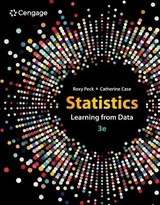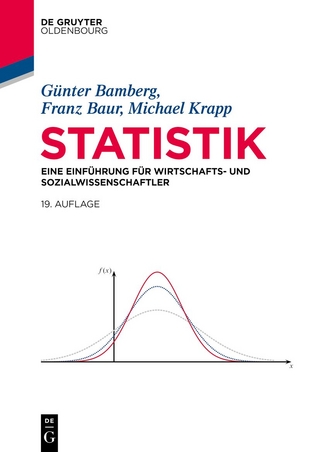
Statistics
Brooks/Cole (Verlag)
978-1-337-55808-2 (ISBN)
- Titel erscheint in neuer Auflage
- Artikel merken
Roxy Peck is emerita associate dean of the College of Science and Mathematics and professor of statistics emerita at California Polytechnic State University, San Luis Obispo. As a faculty member at Cal Poly from 1979 until 2009, Dr. Peck served for six years as chair of the statistics department before becoming associate dean, a position she held for 13 years. She received an M.S. in mathematics and a Ph.D. in applied statistics from the University of California, Riverside. Dr. Peck is nationally known in the area of statistics education, and she was presented with the Lifetime Achievement Award in Statistics Education at the U.S. Conference on Teaching Statistics in 2009. In 2003, she received the American Statistical Association’s Founder’s Award, recognizing her contributions to K-12 and undergraduate statistics education. She is a fellow of the American Statistical Association and an elected member of the International Statistics Institute. Dr. Peck served for five years as the chief reader for the Advanced Placement (AP) Statistics Exam and has chaired the American Statistical Association’s Joint Committee with the National Council of Teachers of Mathematics on Curriculum in Statistics and Probability for Grades K-12 and the Section on Statistics Education. In addition to her texts in introductory statistics, Dr. Peck is co-editor of STATISTICAL CASE STUDIES: A COLLABORATION BETWEEN ACADEME AND INDUSTRY and is a member of the editorial board for STATISTICS: A GUIDE TO THE UNKNOWN, 4TH EDITION. Outside of the classroom, she likes to travel and spends her spare time reading mystery novels. Dr. Peck also collects Navajo rugs and travels to Arizona and New Mexico whenever she can find the time. The late Tom Short was an Associate Professor in the Statistics Program within the Department of Mathematics at West Chester University of Pennsylvania. He also previously held faculty positions at Villanova University, Indiana University of Pennsylvania and John Carroll University. He was a Fellow of the American Statistical Association and received the 2005 Mu Sigma Rho Statistics Education Award. Tom served on the leadership team for readings of the Advanced Placement (AP) Statistics Exam, and on the AP Statistics Development Committee. He also served on the Board of Directors of the American Statistical Association. Tom treasured the time he shared with his four children and the many adventures experienced with his wife, Darlene.
Section I: COLLECTING DATA.
1. Collecting Data in Reasonable Ways.
Statistics: It’s All About Variability. Statistical Studies: Observation and Experimentation. Collecting Data: Planning an Observational Study. Collecting Data: Planning an Experiment. The Importance of Random Selection and Random Assignment: What Types of Conclusions Are Reasonable? Avoid These Common Mistakes. Chapter Activities. Explorations in Statistical Thinking.
Section II: DESCRIBING DATA DISTRIBUTIONS.
2. Graphical Methods for Describing Data Distributions.
Selecting an Appropriate Graphical Display. Displaying Categorical Data: Bar Charts and Comparative Bar Charts. Displaying Numerical Data: Dotplots, Stem-and-Leaf Displays, and Histograms. Displaying Bivariate Numerical Data: Scatterplots and Time-Series Plots. Graphical Displays in the Media. Avoid These Common Mistakes. Chapter Activities. Explorations in Statistical Thinking.
3. Numerical Methods for Describing Data Distributions.
Selecting Appropriate Numerical Summaries. Describing Center and Variability for Data Distributions that are Approximately Symmetric. Describing Center and Variability for Data Distributions that are Skewed or Have Outliers. Summarizing a Data Set: Boxplots. Measures of Relative Standing: z-scores and Percentiles. Avoid These Common Mistakes. Chapter Activities. Explorations in Statistical Thinking.
4. Describing Bivariate Numerical Data.
Correlation. Linear Regression: Fitting a Line to Bivariate Data. Assessing the Fit of a Line. Describing Linear Relationships and Making Predictions--Putting it all Together. Avoid These Common Mistakes. Chapter Activities. Explorations in Statistical Thinking. Bonus Material on Logistic Regression (Online).
Section III: A FOUNDATION FOR INFERENCE: REASONING ABOUT PROBABILITY.
5. Probability.
Interpreting Probabilities. Computing Probabilities. Probabilities of More Complex Events: Unions, Intersections and Complements. Conditional Probability. Calculating Probabilities -- A More Formal Approach. Probability as a Basis for Making Decisions. Estimating Probabilities Empirically and Using Simulation (Optional). Chapter Activities.
6. Random Variables and Probability Distributions.
Random Variables. Probability Distributions for Discrete Random Variables. Probability Distributions for Continuous Random Variables. The Mean and Standard Deviation of a Random Variable. Normal Distribution. Checking for Normality. Binomial and Geometric Distributions (Optional). Using the Normal Distribution to Approximate a Discrete Distribution (Optional). Chapter Activities. Bonus Material on Counting Rules, The Poisson Distribution (Online).
Section IV: LEARNING FROM SAMPLE DATA.
7. An Overview of Statistical Inference -- Learning from Data.
Statistical Inference -- What You Can Learn from Data. Selecting an Appropriate Method -- Four Key Questions. A Five-Step Process for Statistical Inference. Chapter Activities.
8. Sampling Variability and Sampling Distributions.
Statistics and Sampling Variability. The Sampling Distribution of a Sample Proportion. How Sampling Distributions Support Learning from Data. Chapter Activities.
9. Estimating a Population Proportion.
Selecting an Estimator. Estimating a Population Proportion -- Margin of Error. A Large Sample Confidence Interval for a Population Proportion. Choosing a Sample Size to Achieve a Desired Margin of Error. Bootstrap Confidence Intervals for a Population Proportion (Optional). Avoid These Common Mistakes. Chapter Activities. Explorations in Statistical Thinking.
10. Asking and Answering Questions about a Population Proportion.
Hypotheses and Possible Conclusions. Potential Errors in Hypothesis Testing. The Logic of Hypothesis Testing -- An Informal Example. A Procedure for Carrying Out a Hypothesis Test. Large-Sample Hypothesis Tests for a Population Proportion. Randomization Tests and Exact Binomial Tests for One Proportion (Optional). Avoid These Common Mistakes. Chapter Activities. Explorations in Statistical Thinking.
11. Asking and Answering Questions about the Difference between Two Population Proportions.
Estimating the Difference between Two Population Proportions. Testing Hypotheses about the Difference between Two Population Proportions. Inference for Two Proportions Using Data from an Experiment. Simulation-Based Inference for Two Proportions (Optional). Avoid These Common Mistakes. Chapter Activities. Explorations in Statistical Thinking.
12. Asking and Answering Questions about a Population Mean.
The Sampling Distribution of the Sample Mean. A Confidence Interval for a Population Mean. Testing Hypotheses about a Population Mean. Simulation-Based Inference for One Mean (Optional). Avoid These Common Mistakes. Chapter Activities. Explorations in Statistical Thinking.
13. Asking and Answering Questions about the Difference between Two Population Means.
Two Samples: Paired versus Independent Samples. Learning About a Difference in Population Means Using Paired Samples. Learning About a Difference in Population Means Using Independent Samples. Inference for Two Means Using Data from an Experiment. Simulation-Based Inference for Two Means (Optional). Avoid These Common Mistakes. Chapter Activities. Explorations in Statistical Thinking.
Section V: ADDITIONAL OPPORTUNITIES TO LEARN FROM DATA.
14. Learning from Categorical Data.
Chi-Square Tests for Univariate Categorical Data. Tests for Homogeneity and Independence in a Two-Way Table. Avoid These Common Mistakes. Chapter Activities.
15. Understanding Relationships--Numerical Data Part 2 (Online).
The Simple Linear Regression Model. Inferences Concerning the Slope of the Population Regression Line. Checking Model Adequacy.
16. Asking and Answering Questions about More Than Two Means (Online).
The Analysis of Variance -- Single-Factor ANOVA and the F Test. Multiple Comparisons.
Appendix: ANOVA Computations.
| Erscheinungsdatum | 03.02.2018 |
|---|---|
| Verlagsort | CA |
| Sprache | englisch |
| Maße | 220 x 284 mm |
| Gewicht | 2064 g |
| Themenwelt | Schulbuch / Wörterbuch ► Schulbuch / Allgemeinbildende Schulen |
| Mathematik / Informatik ► Mathematik ► Statistik | |
| ISBN-10 | 1-337-55808-7 / 1337558087 |
| ISBN-13 | 978-1-337-55808-2 / 9781337558082 |
| Zustand | Neuware |
| Haben Sie eine Frage zum Produkt? |
aus dem Bereich



